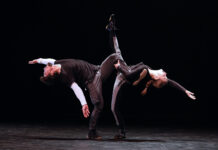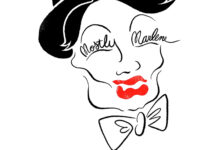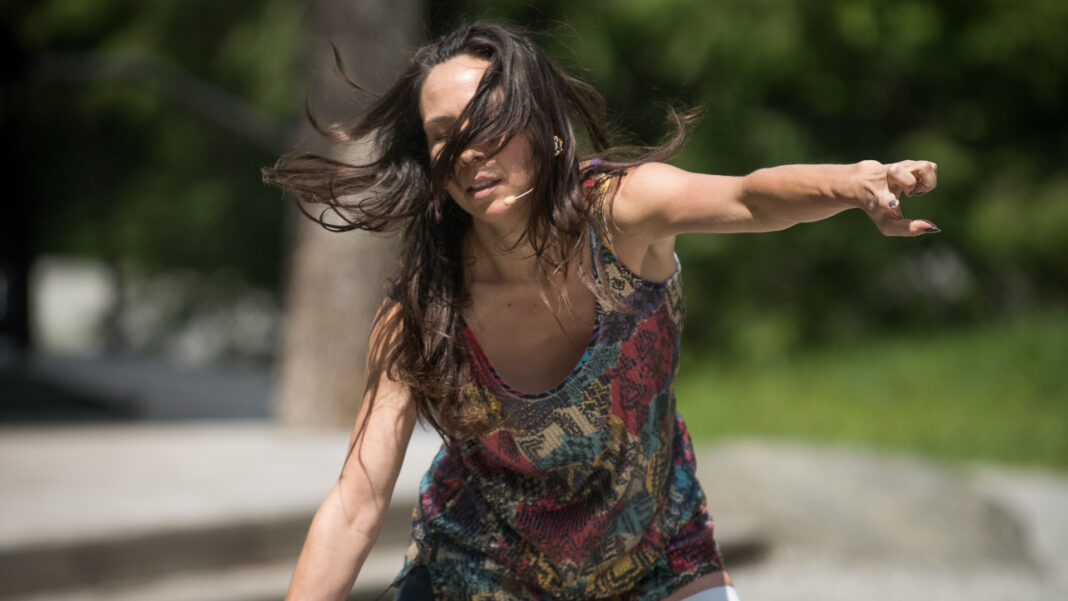Acclaimed choreographer and writer Emily Johnson/Catalyst is inviting you to a gathering. She wants you to come together as a community and not just experience her work, but think about the land where it is taking place. Think about the people who came before you. Think about the people who have gathered with you. That’s how, she hopes, you can start the process of Being Future Being.
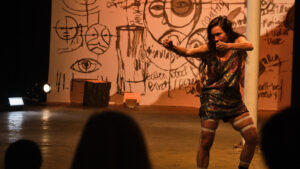
That is the name of her new work which is having its world premiere starting tonight at Santa Monica’s BroadStage and running through Saturday. Johnson has worked on Being Future Being for quite some time beginning with an early residency at Jacob’s Pillow in Massachusetts. Through sound, movement, text and the music of composer Raven Chacon, this gathering will invite you to consider this work, as the BroadStage website says, “As a tangible action that acknowledges the history and colonial occupation of the land on which we reside.”
Johnson is a Guggenheim fellow, a Bessie Award-winner and a recipient of a Doris Duke Award.
Over the weekend I had a chance to talk with Johnson about the work and her relationship with the land on which she creates and the land on which she performs. What follows are excerpts from our conversation that have been edited for length and clarity.
As somebody who became a vegan because of my concern about the environment, I want to start by talking about Being Future Being in terms of our relationship to that environment. Your work is having its world premiere at a time when flooding is impacting Pakistan, wildfires are ravaging the West, Jackson, Mississippi, has no clean water and Las Vegas, New Mexico, has a three-week supply of clean water. That’s just a short list. So what would you like your work to do, vis á vis Being Future Being, to make people look at these problems as more than news stories and something that requires action and a better relationship with the place where we call home?
Thank you for that question and for thinking about about this work relationally. That’s how I started to think about how, not only this work, but really all of the efforts, to think about the work relationally and the ways in which all of our protection efforts, our Indigenous-led projects and efforts, and others are related. We have protection efforts happening all over the world and in a bunch of places in the world that are being affected by climate change – which is driven by capitalism, which is all driven by colonialism.
How can these efforts start to become related and then therefore grow more powerful? Maybe this gathering, this performance gathering, has an effect on us who have chosen to gather the audience in a performance for a brief moment of time. Maybe there’s a way that there’s an overflow from that gathered performance moment that can continue to have an effect where relationships can grow, where we can become again humans right now, where we can become more responsible to a reciprocal relationship to the land that we occupy or that we are from and for the relationships that we inhabit on those lands.
How do you get all of those ideas across in a performing arts work so that the audience understands the points that you’re making? Or is it important for them to understand that?
My intention is to build relationships, to open up a little bit of space for interrogation events, like are we in great relationship with the land that we occupy? Are we in the right relationship right now with everyone who has gathered? Maybe, maybe not. We have to ask these questions of ourselves and of one another. And maybe there is no immediate answer, but maybe there is a starting point or a place to begin or to engage from. This is what I’m really interested in, this overflow from that past performance, following up on that gathering of some that question or that provocation. Then what are trying to do going forward from here? That’s not something that I can control, but tI want to open that space for possibility. And I do want to try to support that possibility.
If you look at that early residency at Jacob’s Pillow, from a creative standpoint, how far has Being Future Being evolved from where you first started it to what you’ll be presenting this week?
I’m very much a process-based person. And, you know, we’ve had a few different iterations of sharing, moments of Being Future Being over the last few years. And so I think of every moment of sharing as a full moment this will be another full moment. It has these words attached to it world premiere, but, it is a moment of sharing as a moment of gathering, moment of calling people together to witness and to be hopefully activated by what is what we offer through a performance, through our stories and through the backstory of this piece as well. So it’s always growing in relation to the specifics of where we are and to the specific moment that we are.
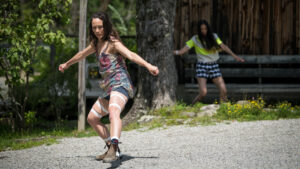
We started by talking about the environment and where we find ourselves right now. I know how important your relationship is to the land on which you grew up, the land on which you’ve lived. As you go from one city to another to perform, how does the land where you’re actually finding yourself in performance vibrate or resonate through you? And how do you think that influences the performance?
Something I’ve practiced for a long time and it’s always think about the land that is underneath [us] and to think about how each of us feels that ground beneath that concrete urban center.
That is the start of acknowledging where I am and then starting to think about how can I be in good relationship with this land and the best that I can be as a visitor here. Trying to be in that relationship is, to me, a start.
Main Photo: Emily Johnson in a work-in-progress presentation of Being Future Being at Jacob’s Pillow (Photo by Cherylynn Tsushima/Courtesy Jacob’s Pillow)





